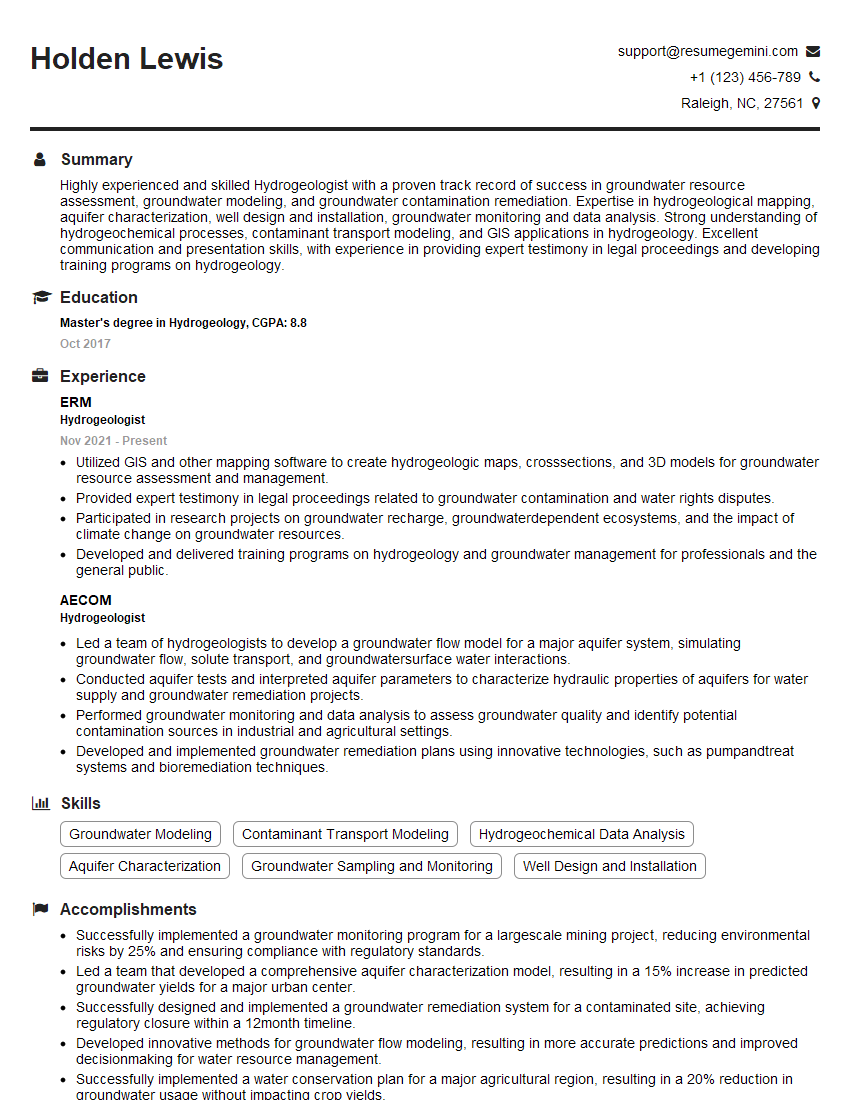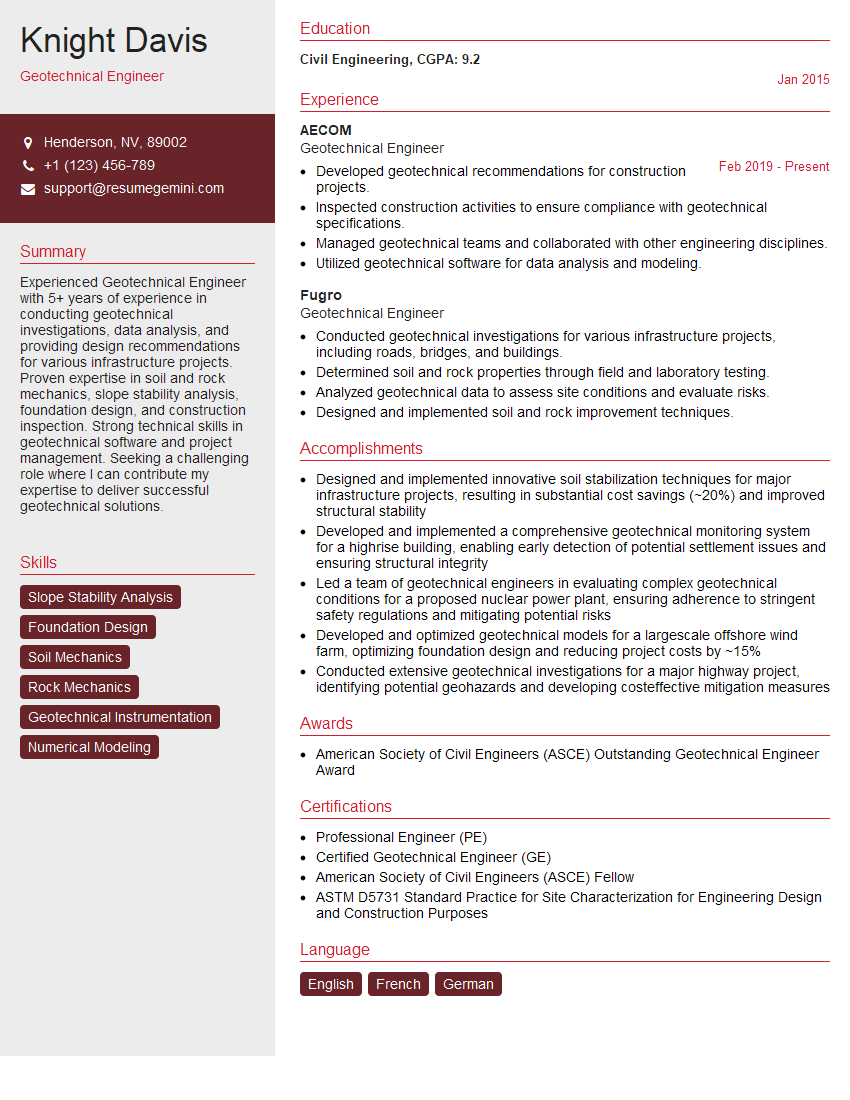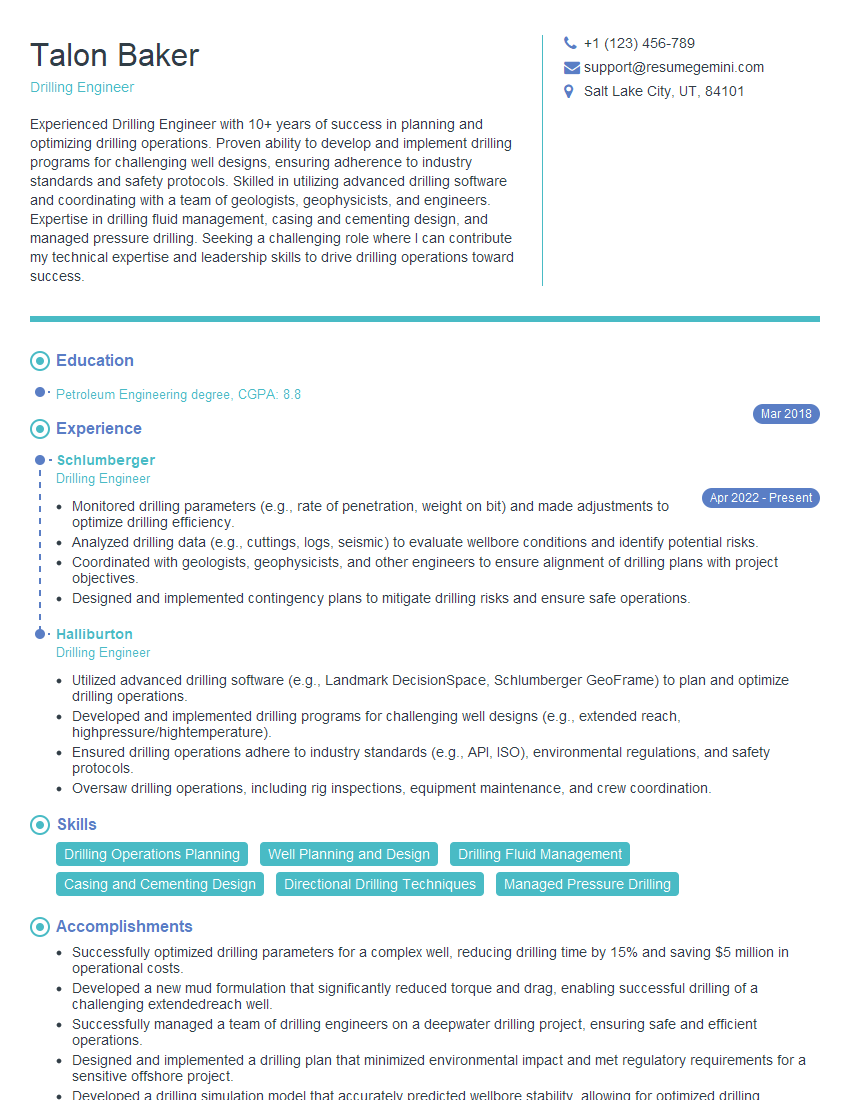Interviews are more than just a Q&A session—they’re a chance to prove your worth. This blog dives into essential Soil and Rock Properties interview questions and expert tips to help you align your answers with what hiring managers are looking for. Start preparing to shine!
Questions Asked in Soil and Rock Properties Interview
Q 1. Explain the difference between cohesionless and cohesive soils.
The primary difference between cohesionless and cohesive soils lies in their ability to resist shear stress when undisturbed. Cohesive soils, like clay, possess significant inter-particle attraction due to electrostatic forces and surface tension. This attraction, called cohesion, allows them to maintain their shape even when not confined. Imagine a clump of wet clay – it holds its form because of this inherent cohesion. Cohesionless soils, such as sand and gravel, lack this significant inter-particle attraction. Their shear strength depends almost entirely on the interlocking of particles and external confinement (like pressure from overlying soil). Think of a pile of dry sand; it readily collapses unless contained.
In simpler terms: Cohesive soils stick together; cohesionless soils don’t. This fundamental difference drastically impacts their engineering behavior, influencing factors like stability, drainage, and compaction characteristics.
Q 2. Describe the various types of soil classifications (e.g., USCS, AASHTO).
Several soil classification systems exist, each with its own advantages and applications. Two prominent ones are the Unified Soil Classification System (USCS) and the American Association of State Highway and Transportation Officials (AASHTO) system. The USCS is widely used in geotechnical engineering and is based on particle size and plasticity characteristics. It employs a two-letter symbol system, for instance, GW (well-graded gravel), CL (lean clay), or ML (silt). The AASHTO system, primarily used for highway construction, categorizes soils based on grain size distribution and group index, reflecting their suitability for pavement construction. The group index is a numerical value indicating the potential for soil expansion or contraction. Each system provides a structured framework for identifying and categorizing soil, guiding design and construction decisions.
Choosing the right system depends on the project’s context. For a large-scale infrastructure project, the USCS’s detailed characterization is crucial. For road construction, AASHTO provides a practical, readily applicable classification.
Q 3. What are the key parameters used to characterize soil strength?
Soil strength, its ability to resist deformation and failure, is characterized by several key parameters. Shear strength is paramount, representing the soil’s resistance to sliding along a plane. This is often expressed using the Mohr-Coulomb failure criterion, defined by cohesion (c) and the angle of internal friction (φ). τ = c + σtanφ where τ is shear strength, σ is normal stress. Compressive strength, the soil’s ability to resist crushing under load, is also important, especially for heavily loaded foundations. Consolidation parameters, such as compression index (Cc) and recompression index (Cr), describe the soil’s behavior under load changes. Understanding these parameters allows engineers to predict settlement and design stable foundations.
For example, a high cohesion and angle of internal friction indicate a strong soil, ideal for supporting heavy structures. Conversely, low values necessitate careful design consideration to prevent instability.
Q 4. Explain the concept of consolidation in soil mechanics.
Consolidation in soil mechanics refers to the gradual reduction in volume of a saturated soil mass due to the dissipation of excess pore water pressure. Imagine squeezing a sponge saturated with water. Initially, much of the pressure is borne by the water. As you continue squeezing (applying load), the water gradually escapes, and the solid particles rearrange, leading to a decrease in volume (settlement). This process happens slowly because the water’s flow through the soil pores is relatively slow, depending on the soil’s permeability.
Consolidation is crucial in foundation design. Predicting settlement due to consolidation is essential for ensuring the stability and longevity of structures. A poorly designed foundation on compressible soil may experience significant settlement over time, leading to structural damage.
Q 5. What are the different types of shear strength tests performed on soils?
Several shear strength tests are employed on soils, each offering insights into specific aspects of the soil’s behavior. The direct shear test involves applying a normal stress to a soil sample and then shearing it until failure. This provides direct measurement of shear strength parameters (c and φ). The triaxial test is more sophisticated, subjecting soil samples to confining pressures and then applying axial stress until failure. It provides a more comprehensive understanding of shear strength under various stress states. The vane shear test is an in-situ test, suitable for soft clays, measuring the undrained shear strength.
The choice of test depends on factors like soil type, project requirements, and accessibility. For example, a direct shear test may suffice for preliminary design, while a triaxial test is crucial for more critical applications.
Q 6. Describe the factors influencing the permeability of soil.
Soil permeability, the ease with which water can flow through the soil, is influenced by various factors. Particle size and grading are critical. Coarse-grained soils (sand and gravel) generally exhibit high permeability, while fine-grained soils (clay and silt) have low permeability due to smaller pore spaces. The void ratio (ratio of pore volume to solid volume) also plays a significant role; higher void ratios lead to higher permeability. The degree of saturation impacts permeability; saturated soils generally have lower permeability than partially saturated soils. Finally, the soil’s structure, including the arrangement and connectivity of pores, influences the overall permeability.
For example, designing a drainage system requires considering soil permeability. High permeability soils require less extensive drainage measures compared to low permeability soils where water may accumulate.
Q 7. Explain the concept of effective stress in soil.
Effective stress in soil is the inter-granular stress, representing the force transmitted through the soil particles. It’s the difference between the total stress (σ) and the pore water pressure (u): σ' = σ - u. Total stress is the total pressure exerted on the soil, while pore water pressure is the pressure exerted by the water within the soil pores. Effective stress is the stress truly carried by the soil skeleton, responsible for the soil’s strength and deformation characteristics. An increase in pore water pressure reduces the effective stress, weakening the soil and increasing the risk of failure.
Imagine a sandcastle on the beach. At high tide, the pore water pressure increases, reducing the effective stress within the sand, leading to collapse. Conversely, at low tide, pore water pressure decreases, increasing the effective stress, making the sandcastle more stable (at least for a little longer!).
Q 8. What are the common methods used for soil stabilization?
Soil stabilization aims to improve the engineering properties of soil, making it suitable for construction purposes. This is often necessary when dealing with weak or unstable soils prone to settlement, erosion, or liquefaction. Common methods fall into several categories:
Mechanical Stabilization: This involves altering the soil’s structure without adding any material. Examples include compaction (using rollers or vibratory equipment to increase density), preloading (applying a load over time to cause consolidation), and densification (techniques like vibro-compaction or dynamic compaction).
Chemical Stabilization: This involves adding chemical agents to modify the soil’s properties. Common methods include cement stabilization (adding cement to bind soil particles), lime stabilization (using lime to improve strength and reduce plasticity), and bitumen stabilization (using bitumen for improved water resistance and strength). The choice of chemical depends on soil type and project requirements.
Thermal Stabilization: This less common method uses heat to alter soil properties. For example, burning organic matter can improve the strength of some soils.
Biostabilization: This involves using microorganisms to improve soil strength. It’s an environmentally friendly approach, but its effectiveness depends heavily on soil conditions and microbial activity.
For instance, imagine building a highway on soft clay. Chemical stabilization with cement might be employed to increase the soil’s bearing capacity, preventing excessive settlement under traffic loads. Conversely, compaction would be a suitable mechanical method for improving the strength of granular soils.
Q 9. Describe the different types of rocks and their engineering properties.
Rocks are classified based on their origin, mineral composition, and texture. These classifications directly influence their engineering properties:
Igneous Rocks: Formed from the cooling and solidification of molten magma. They are generally strong and durable, with examples including granite (high strength, low porosity) and basalt (high strength, can be fractured). Their properties vary greatly depending on cooling rate and mineral content.
Sedimentary Rocks: Formed from the accumulation and cementation of sediments. They exhibit a wider range of properties. Sandstone (moderate strength, porous) and shale (weak, prone to slaking when exposed to water) are common examples. Their strength and durability are significantly influenced by the cementation process.
Metamorphic Rocks: Formed from the transformation of existing rocks under high pressure and temperature. They often exhibit high strength and durability. Examples include marble (relatively weak, can be susceptible to weathering), slate (stronger than marble, good for roofing), and gneiss (strong, variable properties).
Engineering properties to consider include compressive strength (resistance to crushing), tensile strength (resistance to pulling apart), shear strength (resistance to sliding), elasticity (ability to deform and recover), and porosity (amount of void space). These properties dictate the suitability of a rock for various applications, such as foundation support, tunneling, or slope stability.
Q 10. Explain the concept of rock mass classification systems (e.g., RMR, Q-system).
Rock mass classification systems provide a standardized method for assessing the overall strength and stability of a rock mass, considering not only the intact rock strength but also the influence of discontinuities (joints, fractures, faults). Two prominent systems are the Rock Mass Rating (RMR) and the Q-system.
Rock Mass Rating (RMR): This system assigns numerical ratings to various parameters, including intact rock strength, RQD (Rock Quality Designation), spacing of discontinuities, condition of discontinuities, groundwater conditions, and orientation of discontinuities. The sum of these ratings provides an overall RMR value, which can then be used to estimate rock mass strength and suggest appropriate support measures. A higher RMR value indicates a stronger and more stable rock mass.
Q-system: This system utilizes a quantitative approach, considering parameters such as RQD, joint roughness number (Jr), joint alteration number (Ja), joint spacing (Js), groundwater conditions, and the stress reduction factor. These parameters are multiplied to obtain a Q-value. Similar to RMR, a higher Q-value represents a stronger and more stable rock mass. The Q-system is particularly useful for tunnel design.
These systems help engineers make informed decisions regarding excavation techniques, support requirements, and overall project feasibility. For example, a low RMR or Q-value might necessitate extensive rock support in a tunnel to prevent collapse.
Q 11. What are the various methods for determining the in-situ strength of rocks?
Determining the in-situ strength of rocks is crucial for design purposes. Direct methods involve extracting core samples and testing them in the laboratory, but this can be expensive and may not fully represent the in-situ conditions. Therefore, indirect methods are frequently employed:
In-situ testing: Methods like the Schmidt hammer test (measures rebound hardness), the point load test (determines strength from the load required to break a rock core), and the pressuremeter test (measures the deformability of rock) provide estimates of rock strength in the ground.
Plate bearing test: A load is applied to a plate placed on the rock surface, and the resulting settlement is measured. This can provide an estimate of the bearing capacity of the rock mass.
Geophysical methods: Seismic surveys and resistivity surveys can indirectly provide information about the rock mass strength and fracturing. These methods are useful for large-scale investigations.
The choice of method depends on factors like accessibility, cost, and the level of detail required. Often a combination of methods is used to obtain a comprehensive understanding of the rock mass strength.
Q 12. Explain the concept of rock jointing and its influence on rock mass behavior.
Rock jointing refers to the presence of discontinuities (joints, fractures, faults) within a rock mass. These discontinuities significantly influence the rock mass behavior, often reducing its overall strength and stability. The characteristics of rock joints, including their spacing, orientation, roughness, persistence (how far they extend), and infilling material, play a crucial role.
Influence on Rock Mass Behavior: Joints can reduce the rock mass’s strength by providing pathways for water infiltration, leading to weathering and degradation. They can also act as planes of weakness, promoting instability in slopes and excavations. The orientation of joints relative to the direction of stress is critical. For example, joints parallel to a slope face can significantly reduce stability.
Joint Characteristics: Rough, undulating joints tend to be stronger than smooth, planar joints. The presence of infilling material (clay, silt, etc.) can either increase or decrease joint strength, depending on the properties of the infilling material. Closely spaced joints reduce the size of intact blocks, weakening the rock mass more extensively.
Consider a rock slope: If the joints are steeply inclined and well-spaced, the slope may be stable. However, if the joints are closely spaced, sub-parallel to the slope, and filled with weak material, the slope is at high risk of failure.
Q 13. Describe the different types of rock failure mechanisms.
Rock failure mechanisms describe how rocks break under stress. The failure mechanism depends on the type of rock, its strength properties, the stress state, and the presence of discontinuities. Common mechanisms include:
Tensile Failure: Occurs when the rock is subjected to tensile stress exceeding its tensile strength. This typically results in the formation of cracks perpendicular to the direction of the tensile stress.
Shear Failure: Occurs when the shear stress exceeds the shear strength of the rock. This is the most common failure mechanism and often occurs along pre-existing discontinuities or newly formed shear planes.
Compressive Failure: Occurs when the compressive stress exceeds the compressive strength of the rock. This can result in crushing or buckling of the rock mass.
Toppling Failure: Occurs in jointed rock masses where blocks are prone to rotate and topple due to an imbalance of forces. This is commonly seen in slopes with steeply dipping joints.
Block Sliding: Failure along a plane of weakness, such as a joint or fault plane. This occurs when the shear stress exceeds the shear strength along this plane.
Understanding failure mechanisms is crucial for designing stable structures in rock. For example, in tunnel design, the orientation of joints should be carefully considered to avoid shear or toppling failures.
Q 14. What are the common methods used for rock support in underground excavations?
Rock support in underground excavations is crucial to ensure the safety and stability of the structure. The choice of support method depends on factors like the rock mass quality, the geometry of the excavation, and the stress conditions. Common methods include:
Rock bolts: Steel rods anchored into the rock mass to reinforce it and restrain movement. They are frequently used to stabilize unstable blocks or control stress.
Shotcrete: A sprayed concrete layer applied to the excavation walls to provide immediate support and prevent rockfalls.
Mesh and wire reinforcement: Used in conjunction with shotcrete or rock bolts to provide added strength and prevent spalling (fragmentation) of the rock surface.
Steel sets or ribs: Structural steel members used to support weaker rock masses. These are often used in conjunction with other support methods.
Rock support systems: Modern practices often involve integrated systems combining several of the above methods, tailored to the specific needs of the excavation.
For instance, in a deep underground mine, a combination of rock bolts, mesh, shotcrete, and steel sets might be employed to ensure the stability of the tunnels and prevent rockbursts (sudden and violent ejection of rock).
Q 15. Explain the concept of slope stability analysis.
Slope stability analysis is the process of evaluating the likelihood of a slope failing, leading to a landslide or other forms of mass movement. It involves assessing the forces acting on a slope – such as gravity, water pressure, and shear strength of the soil or rock – to determine its factor of safety. A factor of safety greater than 1 indicates stability, while a factor of safety less than 1 indicates potential failure. Imagine a stack of blocks; if the blocks are tightly interlocked and the base is wide, it’s stable. But if the blocks are loose or the base is narrow, it’s more prone to collapse. Slope stability analysis does a similar assessment for natural slopes and engineered cuts.
The analysis considers many factors, including the slope angle, soil type and properties (cohesion, friction angle), groundwater conditions, presence of discontinuities in rock masses, and seismic activity. Different methods are used depending on the complexity of the slope and the available data.
Career Expert Tips:
- Ace those interviews! Prepare effectively by reviewing the Top 50 Most Common Interview Questions on ResumeGemini.
- Navigate your job search with confidence! Explore a wide range of Career Tips on ResumeGemini. Learn about common challenges and recommendations to overcome them.
- Craft the perfect resume! Master the Art of Resume Writing with ResumeGemini’s guide. Showcase your unique qualifications and achievements effectively.
- Don’t miss out on holiday savings! Build your dream resume with ResumeGemini’s ATS optimized templates.
Q 16. What are the different methods for analyzing slope stability?
Several methods exist for analyzing slope stability, each with its own assumptions and applications. Some common methods include:
- Limit Equilibrium Methods: These methods assume that a potential failure surface exists within the slope and that the forces acting on the sliding mass are in equilibrium. Popular examples include the Bishop Simplified method, the Janbu Simplified method, and the Morgenstern-Price method. These methods are relatively simple to apply but require assumptions about the stress distribution within the sliding mass.
- Finite Element Method (FEM): This is a more sophisticated numerical technique that solves the governing equations of soil mechanics to determine stresses and displacements throughout the slope. FEM is particularly useful for analyzing complex geometries and non-homogeneous soil conditions. It requires more computational power and specialized software.
- Limit Analysis Methods: These methods aim to find the minimum load required to cause failure, providing lower-bound estimates of the factor of safety. These are more rigorous but can be computationally intensive.
- Kinematic Analysis: This method involves analyzing potential failure mechanisms by identifying possible failure surfaces and assessing their likelihood of movement based on geometry and material properties. Useful for preliminary assessments and identifying critical failure planes.
The choice of method depends on factors such as the complexity of the slope geometry, the soil or rock properties, the availability of data, and the level of accuracy required.
Q 17. Describe the factors influencing the bearing capacity of soil.
The bearing capacity of soil represents its ability to support the load applied by a foundation. Several factors significantly influence this capacity:
- Soil Type and Properties: The type of soil (e.g., sand, clay, silt) directly affects its bearing capacity. Cohesion, friction angle, and density are crucial parameters. Clay soils, for example, have higher cohesion but lower friction angle compared to sandy soils.
- Depth of Foundation: Deeper foundations generally have higher bearing capacity because they experience greater soil confinement and improved support.
- Groundwater Conditions: The presence of groundwater reduces the effective stress within the soil, thereby decreasing the bearing capacity. A high water table can significantly lower the load-carrying capacity.
- Foundation Geometry: The shape and size of the foundation affect the stress distribution in the soil, influencing the bearing capacity. A wider foundation will generally distribute load more effectively.
- Foundation Load Inclination: Eccentric or inclined loads can result in higher stresses on one side of the foundation, thus reducing the effective bearing capacity.
- Soil Stratification: The presence of different soil layers with varying properties can lead to complex stress distributions and affect bearing capacity.
Engineers use various methods, including empirical formulas and numerical analyses, to estimate the bearing capacity. These calculations are essential in designing safe and stable foundations.
Q 18. Explain the concept of settlement analysis in foundation engineering.
Settlement analysis is a critical aspect of foundation engineering that predicts the amount of vertical deformation (settlement) a structure will undergo due to the load it imposes on the underlying soil. Excessive settlement can lead to structural damage, cracking, and uneven floor levels. Imagine a building resting on a soft, compressible soil; under its weight, the soil will compact, causing the building to sink. Settlement analysis aims to quantify this sinking.
The analysis involves several steps, including determining the soil properties, estimating the stress increase due to the foundation load, and employing appropriate methods to calculate the settlement. Different methods, such as the elastic settlement method and the consolidation settlement method (for clayey soils), are used depending on the soil type and loading conditions. The analysis considers factors like soil compressibility, load magnitude, and foundation size. Careful consideration of settlement is crucial to ensure structural integrity and functionality.
Q 19. What are the different types of foundation systems?
Foundation systems are broadly categorized into shallow and deep foundations. The choice depends on factors such as soil bearing capacity, depth to bedrock, and the size and type of structure.
- Shallow Foundations: These include footings (spread footings, strip footings, combined footings), rafts, and mats. Shallow foundations transfer loads to the soil near the ground surface. They are suitable for stable, high-bearing capacity soils.
- Deep Foundations: These transfer loads to stronger soil or rock layers at greater depths. Examples include piles (driven piles, bored piles, caissons), piers, and drilled shafts. Deep foundations are used when shallow foundations are unsuitable due to weak soil conditions or large loads.
Within these categories, numerous variations and hybrid systems exist, tailoring foundation design to specific site conditions and structural demands.
Q 20. Describe the design considerations for shallow and deep foundations.
Design considerations for shallow and deep foundations differ significantly:
- Shallow Foundations:
- Soil Bearing Capacity: Sufficient soil strength is paramount. Analysis involves determining the allowable bearing pressure to prevent excessive settlement and failure.
- Settlement Analysis: Prediction of total and differential settlement is crucial to prevent damage to the structure.
- Soil Improvement Techniques: Methods like soil compaction, densification, or stabilization might be necessary to enhance bearing capacity if the natural soil is weak.
- Drainage: Proper drainage is essential to prevent water accumulation and reduce pore water pressure, which can significantly affect bearing capacity.
- Deep Foundations:
- Soil Profile Investigation: Detailed geotechnical investigations are crucial to understand the soil layers and locate suitable strata for load transfer.
- Pile Capacity Analysis: Determining the ultimate and allowable load-carrying capacity of piles using appropriate methods and considering factors like pile geometry, soil properties, and installation methods.
- Pile Spacing and Arrangement: Optimizing pile layout for load distribution and minimizing lateral soil movement.
- Settlement Analysis: Assessing the potential settlement of the pile group under the design load.
- Construction Considerations: Detailed construction plans and monitoring are necessary to ensure proper pile installation and quality control.
Both shallow and deep foundations require careful consideration of many factors, including the structural load, soil properties, seismic activity, and environmental conditions, to ensure structural safety and longevity.
Q 21. Explain the principles of groundwater flow and its impact on geotechnical engineering.
Groundwater flow significantly impacts geotechnical engineering. Understanding its principles is crucial for many aspects of design and construction. Groundwater flows from areas of high hydraulic head (water pressure) to areas of low hydraulic head. This flow is governed by Darcy’s Law:
Q = -KA(dh/dl)
where:
Qis the flow rateKis the hydraulic conductivity of the soil (a measure of how easily water flows through it)Ais the cross-sectional area of flowdh/dlis the hydraulic gradient (change in head over distance).
Groundwater affects geotechnical projects in several ways:
- Effective Stress: Groundwater pressure reduces effective stress in soils, affecting shear strength and bearing capacity. High water tables can significantly decrease stability.
- Erosion and Piping: Flowing groundwater can erode soil particles, leading to piping and potential foundation instability. This is particularly important in granular soils.
- Seepage and Uplift Pressure: Water pressure on retaining structures or dams can cause uplift forces, potentially leading to failure. Careful drainage design is crucial to manage this pressure.
- Consolidation and Settlement: In clayey soils, groundwater affects the rate of consolidation (compaction) and settlement. Water drainage is essential for proper consolidation.
- Contamination: Groundwater contamination can be a significant environmental concern, requiring careful site assessment and mitigation measures during construction.
Geotechnical engineers employ various methods to control and manage groundwater effects, such as dewatering, drainage systems, and cutoff walls.
Q 22. How do you conduct a site investigation for a geotechnical project?
A site investigation for a geotechnical project is a crucial first step, ensuring the safe and successful design and construction of any structure. It involves a phased approach combining desk studies, field investigations, and laboratory testing. The goal is to obtain a comprehensive understanding of the subsurface conditions, including soil and rock types, their engineering properties, and groundwater levels.
Desk Study: This initial phase involves reviewing existing geological maps, aerial photographs, historical records, and previous geotechnical reports to gather preliminary information about the site’s geology and potential geotechnical challenges.
Field Investigation: This is where we gather firsthand data. Common methods include:
Trial Pits: Excavations that allow for visual inspection and in-situ testing of the soil.
Boreholes: Drilling into the ground to collect soil and rock samples and conduct in-situ testing like Standard Penetration Tests (SPT) or Cone Penetration Tests (CPT).
Geophysical Surveys: Techniques like seismic refraction or electrical resistivity tomography are used to provide a broader picture of subsurface conditions without extensive excavation.
Laboratory Testing: Soil and rock samples collected during the field investigation are subjected to various laboratory tests to determine their engineering properties, including strength, compressibility, permeability, and shear strength. These tests help quantify the data gathered in the field.
Imagine building a high-rise in a coastal region. A thorough site investigation would be crucial to assess the potential for liquefaction (soil losing strength due to earthquake shaking) and plan suitable mitigation measures. The investigation would involve detailed borehole logging, SPT testing, and laboratory analysis of soil samples to determine their susceptibility to liquefaction.
Q 23. What are the common geotechnical instrumentation techniques?
Geotechnical instrumentation involves installing devices in the ground to monitor ground movements, pore water pressure, and other parameters. This continuous monitoring provides valuable data during construction and the operational life of a structure, allowing for early detection of any potential problems and timely corrective actions. Common techniques include:
Inclinometers: Measure lateral earth movements.
Piezometers: Measure pore water pressure changes.
Settlement Plates: Monitor vertical settlement of structures.
Extensometers: Measure changes in length of structures or soil layers.
Strain Gauges: Measure strain within structural elements or in-situ soil or rock masses.
For example, during the construction of a deep foundation, inclinometers would be installed to monitor potential lateral movements of the soil around the foundation. This data is essential to ensure the foundation’s stability and prevent damage to the structure.
Q 24. Explain the concept of liquefaction and its mitigation measures.
Liquefaction is a phenomenon where saturated, loose sandy soils temporarily lose their strength and stiffness due to earthquake shaking or other rapid loading. The pore water pressure increases dramatically, reducing the effective stress in the soil, making it behave like a liquid. This can lead to ground settlement, lateral spreading, and even failure of structures founded on these soils.
Mitigation measures aim to increase the soil’s resistance to liquefaction. These include:
Soil Densification: Methods like vibrocompaction or dynamic compaction increase soil density, reducing its susceptibility to liquefaction.
Stone Columns: Installing vertical columns of granular material within the liquefiable soil improves drainage and reduces pore water pressure build-up.
Ground Improvement Techniques: Techniques like soil stabilization with cement or lime improve the soil’s shear strength and stiffness.
Foundation Design: Designing foundations with sufficient bearing capacity to resist the effects of liquefaction, like deep foundations.
Imagine a scenario where a highway is built on a liquefiable soil. The design must incorporate stone columns or other ground improvement techniques to reduce the risk of ground failure during an earthquake. Furthermore, the road design might include features that allow for some ground movement without causing major structural damage.
Q 25. Describe your experience with geotechnical software (e.g., PLAXIS, ABAQUS).
I have extensive experience using geotechnical software packages such as PLAXIS and ABAQUS. PLAXIS is particularly useful for analyzing slope stability, retaining wall design, and foundation behavior under various loading conditions. It allows for the creation of realistic 2D and 3D models representing subsurface conditions and material properties, enabling detailed stress-strain analysis.
ABAQUS, while more general-purpose, is powerful for modeling complex geotechnical scenarios and coupled problems, such as soil-structure interaction, considering non-linear behavior and large deformations. I’ve used it to model the behavior of deep excavations, tunnel construction, and the interaction of foundations with layered soils.
For example, using PLAXIS, I’ve modeled the stability of a slope during heavy rainfall, incorporating the changes in soil saturation and strength. This allowed for accurate assessment of the slope’s factor of safety and informed recommendations for slope stabilization measures. Similarly, using ABAQUS, I’ve analyzed the stress distribution around a tunnel during construction, optimizing the support system to maintain the tunnel’s stability.
Q 26. How do you interpret geotechnical laboratory test results?
Interpreting geotechnical laboratory test results requires a thorough understanding of soil mechanics principles and the limitations of the tests themselves. It involves comparing the obtained values with established design criteria and codes of practice. I typically start by checking the test data for consistency and outliers.
For example, the results of a consolidation test yield the soil’s compression index and coefficient of consolidation, parameters vital for predicting settlement under a given load. The results of a direct shear test determine the soil’s shear strength parameters (cohesion and angle of internal friction), crucial for slope stability and foundation design calculations. Understanding the limitations of each test, such as sample disturbance during extraction, is important. I usually incorporate statistical analysis to account for the variability of the measured data. The final interpretation should consider the limitations and uncertainties involved, expressing results using appropriate statistical methods and confidence levels.
Q 27. Explain the process of preparing a geotechnical report.
Preparing a geotechnical report is a meticulous process that ensures all findings and recommendations are clearly communicated to the stakeholders. It begins with a thorough review of the project scope and objectives, followed by a detailed description of the site investigation methodology. Then, the collected data is presented systematically, including:
Site Description: Location, topography, geology.
Methodology: Details of the field and laboratory investigations.
Results: Tabulated data and graphs presenting soil properties.
Interpretation: Analysis and interpretation of the test results, discussion of uncertainties, and presentation of key findings.
Recommendations: Suggestions for appropriate foundation designs, ground improvement techniques, or other measures to address potential geotechnical issues.
Limitations: Acknowledging any limitations of the investigation or assumptions made.
The report is structured for clarity and ease of understanding. It must be clear, concise, and consistent, suitable for both technical and non-technical audiences. A well-written report is crucial for effective communication of technical information and facilitating informed decision-making during the design and construction phases of a project.
Q 28. Describe a challenging geotechnical problem you’ve encountered and how you solved it.
One challenging project involved designing foundations for a large-scale building complex on a site with highly variable soil conditions, including soft clays, dense sands, and a perched groundwater table. Initial assessments underestimated the extent of the soft clay layer, posing a significant settlement risk. To address this, we conducted extensive additional site investigations, including CPT profiling and in-situ vane shear testing to more accurately characterize the soil profile. This revealed a deeper and more extensive soft clay layer than initially anticipated. Consequently, the initial design was revised to incorporate a more robust foundation system, employing a combination of deep piles and ground improvement techniques to mitigate settlement and ensure structural stability. The project success underscored the need for thorough initial investigations and the iterative nature of geotechnical engineering, requiring flexibility in adjusting the design based on new data.
Key Topics to Learn for Soil and Rock Properties Interview
- Soil Classification Systems: Understand the Unified Soil Classification System (USCS) and AASHTO classification, including their practical applications in geotechnical engineering projects.
- Index Properties of Soils: Master the significance of parameters like grain size distribution, Atterberg limits (liquid limit, plastic limit, plasticity index), and specific gravity in determining soil behavior.
- Shear Strength of Soils: Learn about different methods for determining shear strength (direct shear, triaxial testing), and their implications for slope stability and foundation design.
- Consolidation and Settlement: Grasp the concepts of consolidation, primary and secondary settlement, and their prediction using laboratory and field tests. Understand the impact on foundation design.
- Rock Mass Classification: Familiarize yourself with systems like RMR (Rock Mass Rating) and Q-system, understanding their role in assessing rock mass quality for tunneling and slope stability analysis.
- Rock Strength and Deformation: Learn about different rock testing methods (uniaxial compressive strength, tensile strength, etc.) and their significance in determining rock mass behavior.
- Permeability and Seepage: Understand the concepts of permeability in both soils and rocks, and their impact on groundwater flow and stability. Know how to analyze seepage problems.
- Practical Applications: Be prepared to discuss real-world applications of soil and rock properties in various geotechnical engineering projects, such as highway design, dam construction, and foundation engineering.
- Problem-Solving Approaches: Practice solving numerical problems related to soil and rock mechanics using relevant equations and principles. Develop your ability to interpret test data and make engineering judgments.
Next Steps
Mastering Soil and Rock Properties is crucial for a successful career in geotechnical engineering, offering diverse opportunities and challenging projects. A strong understanding of these fundamental principles will significantly enhance your prospects and make you a highly sought-after candidate. To increase your chances of landing your dream job, focus on building an ATS-friendly resume that highlights your skills and experience effectively. ResumeGemini is a trusted resource that can help you create a professional and impactful resume. They provide examples of resumes tailored to the Soil and Rock Properties field, ensuring your application stands out from the competition. Invest in yourself and your future; create a winning resume today!
Explore more articles
Users Rating of Our Blogs
Share Your Experience
We value your feedback! Please rate our content and share your thoughts (optional).
What Readers Say About Our Blog
Hi, I have something for you and recorded a quick Loom video to show the kind of value I can bring to you.
Even if we don’t work together, I’m confident you’ll take away something valuable and learn a few new ideas.
Here’s the link: https://bit.ly/loom-video-daniel
Would love your thoughts after watching!
– Daniel
This was kind of a unique content I found around the specialized skills. Very helpful questions and good detailed answers.
Very Helpful blog, thank you Interviewgemini team.





